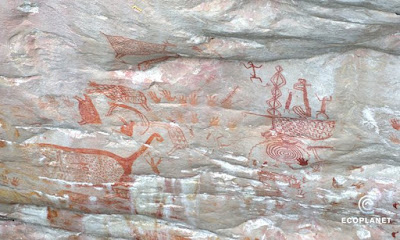Prehistoric paintings on vertical rock face in wilderness photographed and filmed for the first time.
Images of rock art that could be 20,000 years old, found in Chiribiquete national park, Colombia. Photograph: Francisco Forero Bonell/Ecoplanet
A British wildlife film-maker has returned from one of the most inaccessible parts of the world with extraordinary footage of ancient rock art that has never been filmed or photographed before.
In an area of Colombia so vast and remote that contact has still not been made with some tribes thought to live there, Mike Slee used a helicopter to film hundreds of paintings depicting hunters and animals believed to have been created thousands of years ago. He said: “We had crews all over the place and helicopters filming all over Colombia. As a photographer, Francisco Forero Bonell discovered and took the pictures for my movie.”
The extraordinary art includes images of jaguar, crocodiles and deer. They are painted in red, on vertical rock faces in Chiribiquete national park, a 12,000 square kilometre Unesco world heritage site that is largely unexplored. There are also paintings of warriors or hunters dancing or celebrating. “It is the land that time forgot,” Slee told the Observer.
There had previously been only vague reports of rock art in the area, which is known as Cerro Campana, he said: “There’s no information, maps or communication. It’s such a massive central part of Colombia.” Though some paintings had previously been found and photographed elsewhere in Chiribiquete, this Cerro Campana art has never been filmed or photographed, Slee said: “It was an absolutely stunning moment to be able to get the footage.”
Slee used a helicopter to gain access to the area, as the terrain is impenetrable – thick vegetation, forested rock peaks and valleys, sheer cliffs and giant rock towers soaring through a rainforest canopy.
Professor Fernando Urbina, a rock art specialist from the National University of Colombia, was struck by the “magnificent naturalism” of the depictions of deer when shown the photographs.
“They reveal the hand of a master of painting,” he said, adding that the paintings could be up to 20,000 years old. He was particularly interested in a human figure in a seated position whose arms appear to be folded over his shoulders, a ritual position in Amazonian cultures. “A seated man has special significance as the sage of the tribe,” he said.
The art may have been painted by the Karijona tribe, a few of whose members still live in the region. The seated position might suggest a prisoner or slave, Urbina said.Jean Clottes, a French prehistorian, and author of Cave Art – a book covering key sites such as Lascaux in France – described the images as exciting and well-preserved, but said it would be hard to determine their age because radiocarbon dating could not be used, as they were painted with mineral-based materials derived from iron oxide rather than the charcoal used in European rock art.
The species depicted are thought to include capybaras, snakes and anteaters. Slee described the art as a wildlife chapel. “The peoples who once lived here have left in pictures testimony of their awe and respect for the wild,” he said. “When I saw the images, I honestly felt an affinity with the artists. They were attempting to capture the power, grace, spirit and essence of the animal in pictures. Perhaps it was to make the hunt better next day, but there is clearly careful observation in their art. It’s what contemporary photographers, painters, film-makers set out to do when they create a wildlife project.”
Slee made his name making natural history films and directed the movie Bugs! 3D, about two rainforest insects, narrated by Judi Dench. In 2012, the Observer reported that his Flight of the Butterflies 3D had captured butterflies in unprecedented detail, moving scientists to tears at an early screening. Over the past three years, Slee has been exploring Colombia to make Colombia: Wild Magic, which will be in cinemas next year. Through spectacular footage, it portrays “a majestic tropical wilderness” – but one he said was threatened by humans who are “taking more than they are giving”. With swooping aerial footage and detailed close-ups, it reveals a landscape of canyons and caves, lakes and lagoons, rivers and rock masses with “the largest varieties of living things on the planet”, including unique species of hummingbird and endangered jaguar.
Drawing on the expertise of a dozen scientific advisers, the film warns of threats from the world’s “craving” for natural resources such as gold and emeralds. Slee said: “We’ve got illegal gold-mining polluting the rivers, we’re overfishing the seas, the habitat destruction is massive. We’re taking out the rainforest, we’re losing species every week. We have the most beautiful country on Earth and we are in danger of destroying it. There are places that no Colombian has been. It’s mainly because, when you think of Colombia, you think of kidnapping and drugs.”
Bonell, a Colombian conservationist and photographer, was inspired to become executive producer of the film, describing the region as “one of the few areas on our planet that still remains unspoiled and unexplored”.
The film has been produced by British company Off The Fence, and will be distributed free in schools in Colombia, as well as cinemas, “spreading the word about what their country has and the need to protect it”, Slee said. Slee hopes to return for another large-scale expedition focusing on the rock art. “We’ve probably only scratched the surface,” he said. “There are believed to be many hundreds of these cave paintings dotted throughout that central region.”





















No comments:
Write σχόλια